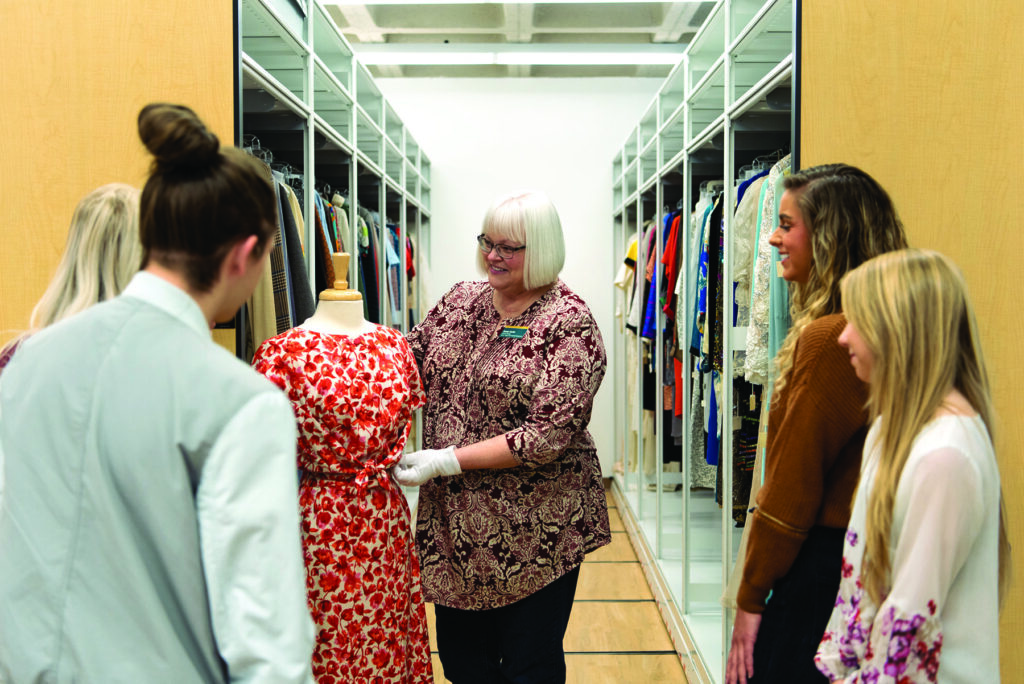
Curator Susan Carter shows a dress from the Emily Reynolds Costume Collection to students. (Photos/Emily Reynolds Historic Costume Collection, NDSU.)
Nancy Edmonds Hanson
The curator of North Dakota State University’s extensive historical clothing collection will address one of the most persistent mysteries of female fashion next week in a program sponsored by the Historical and Cultural Society of Clay County: Why pockets are so miserably scarce in women’s clothes.
It’s a dilemma that may seem minor to males, who take those handy in-seam amenities for granted – a place to park their hands and incidentally insert their wallets, their keys, loose change and ever-present cellphones. If they were forced to tote handbags to accommodate those necessities, perhaps they too would wonder.
“Ask any woman how she feels about the pockets in her clothing, and you will get a strong response,” HCSCC Executive Director Maureen Kelly Jonason observes.
Susan Curtis, who manages NDSU’s Emily Reynolds Historical Costume Collection, will address the mystery of the missing pockets in a free public presentation at the Hjemkomst Center Sept. 12 at 6:30 p.m. Her talk is entitled “Pockets of Time: The Gendered History of How We Carry Things.” The presentation explores how the pocket developed in European and American clothing, and how it became a point of contention among women in the 20th century.
“Why do men’s clothes have functional pockets and women’s do not?” Curtis asks, and answers: “It’s a really amazing story with social reason behind it.”
In medieval times, the NDSU textiles expert explains, neither gender had pockets. Instead, they wore little fabric pouches tied onto their belts to hold the small items they carried with them.
In the 1700s, however, tailors began incorporation men’s pouches into their clothing. Women’s garb didn’t follow the new practice. Instead, she says, they continued to use large fabric pockets, or pouches, tied around their middles. “If they had a lot to carry, they might wear two or three of them,” she says.
The reason: Females’ status in society. Through the 1700s and 1800s, she explains, they could own no property in their own names. Nor could they travel without a man to accompany them. Anything that needed carrying was the province of the male. And while men quickly took to walking with their hands tucked into the pockets in their coats or pants, etiquette decried that luxury for women. “Inserting your hands into anything other than gloves was considered terribly unladylike,” she says.
Changing dress fashions affected the practical side of incorporating pockets. Slimmer skirts left little room for pouches sewn into their seams. Eventually the return to voluminous skirts did open up possibilities. “After the 1850s, you might find dressmakers adding a pocket here and there in those big skirts,” Curtis notes, “but where to place it was not standardized. You might find a pocket in the waistband, in the bustle, even in the hem of the skirt. Finding those pockets was a treasure hunt.” Too, they were relatively tiny: “They might hold a few coins, a handkerchief or a house key. They certainly weren’t large enough for your hands.”
It was the rise of the women’s suffrage movement, she says, that enabled females to seek the men’s coveted in-seam pockets for themselves. “It became known as the Rational Dress Movement,” she reports. By 1910, it had led to an outfit called the Suffragette Suit, with pocketed coats and full trousers resembling a skirt that equipped with the kind of pockets long enjoyed by men – as one newspaper described them, “pockets into which the speech-making suffragette can place her hands in her pockets, man-fashion.”
“But the suits were incredibly expensive,” Curtis notes, “and the anti-suffragettes wouldn’t buy them, so they never really caught on.”
Meanwhile, high fashion luggage makers like Louis Vuitton and Hermes stepped into the world of prestigious, high-ticket purses – another good reason to prevent the ladies from carrying their gear in their clothing, and one that lingers today.
As women finally got the vote, she says, “There was an explosion of pockets in the 1920s and up to World War II.” It wasn’t a coincidence. She observes, “That’s when we had the highest proportion of women designers.”
But the pocket population closed up after the war as the ladies left the workforce. In the 1950s, designers – including Christian Dior – decided that men’s pockets were there to put things in, while women’s would be strictly decorative. “From the ’50s onward, aesthetics ruled. Women’s bodies were somewhere to display fashion, and function slipped away,” Curtis explains.
Only now, with the rise of practical athletic wear, has that trend begun to reverse. “We’re seeing more pockets lately,” the fashion collection curator observes.
But inequality still reigns in the world of pockets. She refers to a 2018 study that measured the front pockets of blue jeans from the top 20 manufacturers, half targeting males, the rest females. “Women’s pockets were 48% shorter and 6.5% narrower than men’s,” she points out, the differential maintained across similarly sized jeans large and small.
“Less than half could fit wallets, even those specifically designed to go in front pockets.
“It should make us think,” the expert in historical fashions points out. “As consumers, we do have the power to make things change …. if we want to.”


